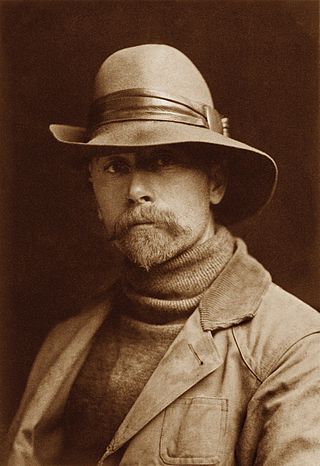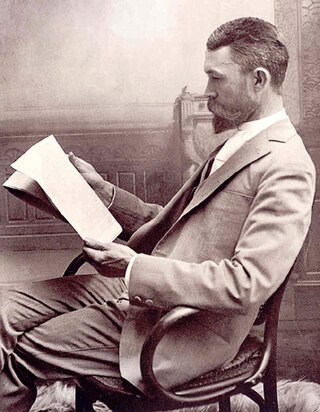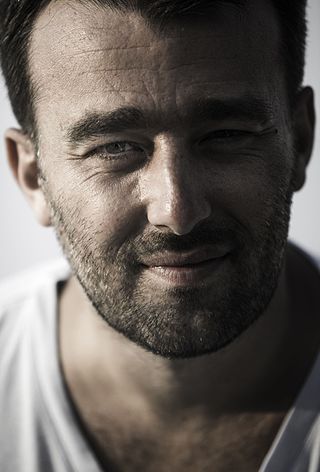
Survival International is a human rights organisation formed in 1969, a London based charity that campaigns for the rights of Indigenous and/or tribal peoples and uncontacted peoples.

Edward Sherriff Curtis was an American photographer and ethnologist whose work focused on the American West and on Native American people. Sometimes referred to as the "Shadow Catcher", Curtis traveled the United States to document and record the dwindling ways of life of various native tribes through photographs and audio recordings.

Salvage ethnography is the recording of the practices and folklore of cultures threatened with extinction, including as a result of modernization. It is generally associated with the American anthropologist Franz Boas; he and his students aimed to record vanishing Native American cultures. Since the 1960s, anthropologists have used the term as part of a critique of 19th-century ethnography and early modern anthropology.

Adam Clark Vroman was an American portrait photographer, known primarily for his portraits of indigenous peoples of the Southwestern United States. He was the founder and proprietor of Vroman's Bookstore - the oldest and largest independent bookshop in Southern California.

Samuel Joseph Haskins, was a British photographer, born and raised in South Africa. He started his career in Johannesburg and moved to London in 1968. Haskins is best known for his contribution to in-camera image montage, Haskins Posters (1973) and the 1960s figure photography trilogy Five Girls (book) (1962), Cowboy Kate & Other Stories (1964) and November Girl (book) (1967), plus an ode to sub-saharan tribal Africa "African Image (book) (1967).
Mark Alan Seliger is an American photographer noted for his portraiture. From 1992 to 2002, he was Chief Photographer for Rolling Stone, during which time he shot over 188 covers for the magazine. From 2002 to 2012 he was under contract with Condé Nast Publications for GQ and Vanity Fair and has shot for numerous other magazines. Seliger has published a number of books, including When They Came to Take My Father: Voices of the Holocaust, Physiognomy, and On Christopher Street: Transgender Stories, and his photographs are included in the permanent collections of the National Portrait Gallery at the Smithsonian Institution, the Museum of Fine Arts in Houston, and the National Portrait Gallery in London. He has done advertising work for Adidas, Amazon, Anheuser-Busch, Apple, Dom Pérignon, Fila, Gap, HBO, Hourglass Cosmetics, Hulu, KITH, Lee Jeans, Levi's, McDonald's, Netflix, Ralph Lauren, Ray-Ban, Rolex, Showtime, Sony, Universal and Viacom, among others. He is also the lead singer of the country band Rusty Truck.
The pioneers of photography in the Philippines were Western photographers, mostly from Europe. The practice of taking photographs and the opening of the first photo studios in Spanish Philippines, from the 1840s to the 1890s, were driven by the following reasons: photographs were used as a medium of news and information about the colony, as a tool for tourism, as an fork anthropology, as a means for asserting social status, as an implement for historical documentation, as a team for communication, as materials for propaganda, and as a source of ideas for illustrations and engravings. The practice of photography in the Philippines was not without the influence and influx of Western-art concepts into the colonized archipelago.

Horace Poolaw (1906–1984) was a Kiowa photographer from Mountain View, Oklahoma.

Stephen Corry is a British indigenous rights activist, better known as the former CEO of Survival International. He was asked to lead the organisation in 1984. In 1993 he became the chairman of the Free Tibet Campaign and remains on its board.
Benedicte Marie Wrensted was a notable Danish-American photographer, who emigrated to the United States after running a studio for a few years in Horsens, Denmark. She was an obscure photographer who is most notably remembered for her documentation of the Northern Shoshone, Lemhi, and Bannock tribes in Idaho between 1895-1912.

Photography by indigenous peoples of the Americas is an art form that began in the late 19th century and has expanded in the 21st century, including digital photography, underwater photography, and a wide range of alternative processes. Indigenous peoples of the Americas have used photography as a means of expressing their lives and communities from their own perspectives. Native photography stands in contrast to the ubiquitous photography of indigenous peoples by non-natives, which has often been criticized as being staged, exoticized, and romanticized.
Samuel Fosso is a Cameroonian-born Nigerian photographer who has worked for most of his career in the Central African Republic. His work includes using self-portraits adopting a series of personas, often commenting on the history of Africa. One of his most famous works of art, and what he is best known for, is his "autoportraits" where he takes either himself or other more recognizable people and draws them in a style of popular culture or politics. He is recognized as one of Central Africa's leading contemporary artists.
Larry McNeil is a Native American photographer and printmaker. His photographs range on subjects and formats from realist portraits to tribal elders, from abstract cityscapes to electronic manipulations of tribal environments. His images are considered personally meaningful as they are representative of tribal realities and highlight the sensitivity behind the representation of Native Americans.
Project 562 is a photography project by Matika Wilbur, in which the artist is documenting and depicting at least one contemporary Native American person from each of the 562 currently recognized Tribal Nations in the United States.

Réhahn is a French photographer based in Hoi An, Vietnam. Known as the photographer that "captures souls", he is recognized for his portraits of Vietnam, Cuba, Malaysia and India, and for his cultural preservation work.
Matika Wilbur, is a Native American photographer and educator from Washington state. She is an enrolled citizen of the Tulalip Tribes of Washington and a descendant of the Swinomish people. She is best known for her photography project, Project 562.
Felipe Tomas Lettersten (1957–2003) was a Peruvian-born Swedish sculptor. Starting in 1986, Lettersten started preserving the Amazon rainforest cultures by casting sculptures of indigenous people. He wanted to educate the Western world on respecting Indian cultures. His cast sculptures are often placed on pedestals. Lettersten was known to makes three copies of a sculpture, sending one to the tribe as a gesture of respect, the second was sold and the third copy exhibited.

Photography in Sudan refers to both historical as well as to contemporary photographs taken in the cultural history of today's Republic of the Sudan. This includes the former territory of present-day South Sudan, as well as what was once Anglo-Egyptian Sudan, and some of the oldest photographs from the 1860s, taken during the Turkish-Egyptian rule (Turkiyya). As in other countries, the growing importance of photography for mass media like newspapers, as well as for amateur photographers has led to a wider photographic documentation and use of photographs in Sudan during the 20th century and beyond. In the 21st century, photography in Sudan has undergone important changes, mainly due to digital photography and distribution through social media and the Internet.
Alexander Khimushin is a Russian ethnographic photographer. He was born and raised in Yakutia, Siberia. He currently lives in North Queensland, Australia.

The Precious Heritage Art Gallery and Cultural Museum is a museum in Hoi An, Vietnam. Inaugurated on 1 January 2017, the museum presents the diverse cultures of Vietnam's ethnic groups through large-scale portraits, traditional costumes, stories and public education. The Precious Heritage Museum is the culmination of the Precious Heritage Project, a photographic endeavor undertaken over a decade by the French photographer Réhahn.











